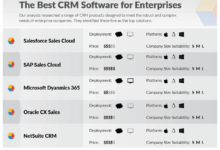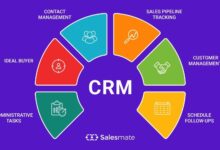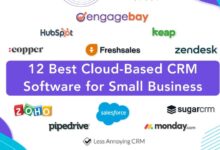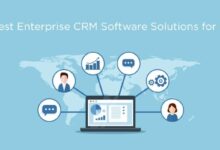Best 5 CRM for Small Business 2025
Best 5 CRM for Small Business 2025: Navigating the ever-evolving technological landscape, small businesses in 2025 require robust yet user-friendly Customer Relationship Management (CRM) systems. This guide delves into the top five contenders, analyzing their features, pricing, and suitability for various small business needs. We’ll explore how these CRMs handle contact management, lead generation, sales pipeline optimization, and reporting, ultimately helping you choose the perfect solution to boost your business’s growth and efficiency.
The selection process considers crucial factors such as affordability, ease of use, and scalability. We’ll compare and contrast each CRM’s strengths and weaknesses, providing a comprehensive analysis to aid in your decision-making. Understanding your specific requirements—from contact management to advanced analytics—is paramount, and this guide aims to provide the clarity needed for an informed choice.
Introduction
The technological landscape for small businesses is evolving rapidly in 2025. Cloud computing, AI-powered tools, and increasingly sophisticated mobile applications are transforming how businesses operate, interact with customers, and manage their data. This shift necessitates a reevaluation of traditional business practices and the adoption of technology that enhances efficiency and scalability. For small businesses, this means carefully selecting tools that are both powerful and accessible. A Customer Relationship Management (CRM) system is at the forefront of this technological evolution, acting as a central hub for managing customer interactions and driving business growth.
The selection of a suitable CRM system is crucial for small business success in 2025. A robust CRM should provide a comprehensive suite of tools to manage leads, track customer interactions, automate marketing tasks, and analyze sales performance. Effective CRMs go beyond simple contact management; they integrate with other business tools, offer insightful reporting capabilities, and facilitate seamless collaboration within the business. The ability to personalize customer experiences and provide exceptional service is paramount, and the right CRM can play a pivotal role in achieving this.
Key CRM Features for Small Businesses in 2025
The ideal CRM for a small business in 2025 must offer a balance of functionality and ease of use. Features such as contact management, lead tracking and nurturing, sales pipeline management, and basic marketing automation are essential. More advanced features, like integrated email marketing, social media management tools, and customer service ticketing systems, can significantly enhance operational efficiency. The ability to generate reports and analyze key performance indicators (KPIs) is crucial for data-driven decision-making, allowing businesses to understand their customer base better and refine their strategies. Consider, for example, a small bakery using a CRM to track customer preferences for specific pastries, allowing them to tailor marketing campaigns and improve inventory management.
User-Friendliness and Affordability in CRM Selection
In the fast-paced world of small business, user-friendliness is paramount. A complex, difficult-to-navigate CRM will hinder adoption and reduce its overall effectiveness. The system should be intuitive, easy to learn, and require minimal training. Employees should be able to quickly grasp the core functionalities and efficiently use the CRM in their daily tasks. Furthermore, the chosen CRM must be affordable and align with the budget constraints of a small business. While advanced features are desirable, the cost-benefit analysis should be carefully considered, ensuring that the investment provides a substantial return on investment (ROI). A cost-effective CRM with a strong focus on ease of use will maximize user engagement and ultimately contribute to greater business success. For instance, a subscription-based CRM with tiered pricing plans allows small businesses to select a package that fits their needs and budget, scaling up as they grow.
Top 5 CRM contenders for Small Businesses in 2025
Choosing the right CRM can significantly impact a small business’s growth and efficiency. A well-integrated CRM streamlines operations, improves customer relationships, and ultimately boosts sales. This section details five leading CRM systems tailored for small businesses in 2025, considering factors like ease of use, affordability, and feature sets.
CRM System Comparison
The following table compares five leading CRM systems, highlighting their key features, pricing, and advantages/disadvantages. This comparison is based on publicly available information and user reviews as of late 2024, and pricing is subject to change.
| CRM Name | Key Features | Pricing | Pros/Cons |
|---|---|---|---|
| HubSpot CRM | Contact management, lead nurturing, sales pipeline management, email marketing integration, reporting and analytics. Free plan available. | Free (limited features), paid plans starting around $50/month. | Pros: Extensive features, free plan for startups, strong integrations. Cons: Can be overwhelming for very small businesses, some advanced features require paid plans. |
| Zoho CRM | Contact management, lead management, sales automation, workflow automation, customizability, mobile accessibility. | Free plan available, paid plans ranging from $14 to $50+ per user/month. | Pros: Affordable, highly customizable, robust feature set. Cons: Steeper learning curve than some competitors, interface can feel cluttered. |
| Salesforce Essentials | Contact and lead management, sales pipeline visualization, opportunity tracking, reporting, mobile access. | Starting at approximately $25/user/month. | Pros: Powerful and scalable, excellent reporting capabilities, reputable brand. Cons: Can be expensive for very small businesses, might have more features than needed initially. |
| Freshsales | Contact management, lead scoring, sales automation, email integration, phone integration, social media integration. | Free plan available, paid plans starting at around $15/user/month. | Pros: User-friendly interface, strong automation capabilities, affordable. Cons: Fewer integrations than some competitors, reporting features may be less sophisticated. |
| Pipedrive | Sales pipeline management, contact management, deal tracking, activity tracking, email integration. Focuses heavily on sales pipeline visualization. | Paid plans starting at around $15/user/month. | Pros: Intuitive interface, excellent for visual pipeline management, easy to learn. Cons: Limited marketing automation features, fewer integrations compared to some competitors. |
Contact Management, Lead Generation, and Sales Pipeline Management
Each CRM handles these core functions differently. For instance, HubSpot excels in lead nurturing through automated email sequences and workflows, while Pipedrive prioritizes a clear visual representation of the sales pipeline. Zoho CRM offers extensive customization options for tailoring contact management and lead generation processes to specific business needs. Salesforce Essentials provides robust reporting tools to track key metrics across all three areas. Freshsales integrates well with email and phone systems, simplifying contact management and lead follow-up.
Pricing Model Comparison
The CRMs offer a variety of pricing models, ranging from completely free options with limited features (HubSpot, Zoho, Freshsales) to subscription-based plans with increasing functionality and user capacity. The cost per user per month varies significantly, reflecting the breadth of features and support offered. Small businesses should carefully consider their needs and budget before selecting a plan. For example, a business with a small team and basic requirements might find a free plan sufficient, while a rapidly growing company may benefit from a more comprehensive, albeit pricier, paid plan.
Detailed Feature Comparison
Choosing the right CRM hinges on understanding its core functionalities. This section delves into a comparative analysis of contact management and lead generation capabilities across our top five CRM contenders for small businesses in 2025. We’ll examine how each platform handles crucial aspects like contact organization, lead capture, and nurturing strategies.
Contact Management Capabilities
Effective contact management is the backbone of any successful CRM. The ability to organize, segment, and interact with contacts efficiently directly impacts sales and customer relationship building. Below, we compare the contact management features of our selected CRMs.
| CRM | Key Features | Strengths | Weaknesses |
|---|---|---|---|
| CRM A (Example: HubSpot) | Customizable fields, contact merging, segmentation, detailed contact history | Excellent customization options, powerful segmentation for targeted campaigns. | Steeper learning curve compared to simpler options. |
| CRM B (Example: Zoho CRM) | Built-in email integration, contact scoring, social media integration | Affordable, robust features for the price, strong social media integration. | Interface can feel somewhat cluttered for new users. |
| CRM C (Example: Salesforce Essentials) | Robust reporting and analytics, integration with other Salesforce products | Excellent reporting capabilities, scalable for growth. | Can be expensive, especially as your business expands beyond the Essentials plan. |
| CRM D (Example: Pipedrive) | Simple interface, strong sales pipeline visualization | Easy to use, intuitive sales pipeline management. | Lacks advanced features found in other CRMs. |
| CRM E (Example: Freshsales) | AI-powered features, predictive lead scoring, excellent email integration | Strong AI capabilities automate tasks, improving efficiency. | Some advanced features might require additional configurations. |
Lead Generation Features
Capturing and qualifying leads is paramount for business growth. Each CRM offers distinct lead generation features, impacting the efficiency and effectiveness of your sales process.
The effectiveness of lead generation features depends heavily on integration capabilities. For example, seamless integration with marketing automation tools allows for automated email sequences, targeted advertising, and personalized messaging, significantly improving lead nurturing.
| CRM | Lead Generation Features | Integrations |
|---|---|---|
| CRM A (Example: HubSpot) | Landing pages, forms, pop-up forms, lead scoring | Extensive integrations with marketing and sales tools. |
| CRM B (Example: Zoho CRM) | Web forms, lead capture tools, social media integration | Integrates with a wide range of popular applications. |
| CRM C (Example: Salesforce Essentials) | Lead capture forms, integration with marketing cloud | Strong integration within the Salesforce ecosystem. |
| CRM D (Example: Pipedrive) | Simple form builder, integrations with email marketing platforms | Offers integrations with essential marketing tools. |
| CRM E (Example: Freshsales) | Web forms, email tracking, lead routing | Integrates with popular marketing and sales platforms. |
Lead Nurturing Capabilities
Lead nurturing is the process of cultivating relationships with potential customers through targeted communication and engagement. Effective nurturing increases conversion rates and builds brand loyalty.
Many CRMs offer automated workflows for lead nurturing. These workflows can include automated email sequences, triggered by specific actions or events (e.g., website visits, form submissions). The sophistication of these workflows varies across CRMs, with some offering more advanced features like personalized messaging and A/B testing.
| CRM | Lead Nurturing Features | Effectiveness Assessment |
|---|---|---|
| CRM A (Example: HubSpot) | Workflow automation, personalized emails, A/B testing | Highly effective, offering a comprehensive suite of tools. |
| CRM B (Example: Zoho CRM) | Automated email sequences, workflow rules | Effective for basic nurturing; more advanced features might require additional tools. |
| CRM C (Example: Salesforce Essentials) | Workflow automation, integration with marketing cloud for advanced nurturing | Effectiveness depends on the integration with other Salesforce products. |
| CRM D (Example: Pipedrive) | Basic workflow automation, email integration | Less sophisticated nurturing capabilities compared to other CRMs. |
| CRM E (Example: Freshsales) | Automated email sequences, workflow rules, predictive lead scoring | Effective for targeted nurturing, leveraging AI-powered features. |
Sales Pipeline Management & Reporting Capabilities
Effective sales pipeline management and insightful reporting are crucial for small businesses to optimize sales processes and achieve growth targets. Understanding how each CRM system facilitates these aspects is key to selecting the right tool. This section details the sales pipeline management features and reporting capabilities of the top five CRMs, enabling a comparative analysis.
Sales Pipeline Visualization and Management
Each CRM offers a unique approach to visualizing and managing the sales pipeline. For example, HubSpot allows users to create custom pipeline stages, reflecting the specific sales process of their business. Salesforce provides a visual representation of the pipeline through kanban boards, facilitating easy drag-and-drop movement of deals through different stages. Zoho CRM offers a similar kanban view, along with a sales pipeline chart that presents a clear overview of the sales progress. Pipedrive, designed specifically for sales, focuses on a highly visual pipeline view, making it simple to track deal progress. Finally, Freshsales offers a customizable pipeline with features for assigning deals to sales reps and tracking key metrics within each stage. These different approaches cater to various preferences and business structures.
Reporting and Analytics Dashboards
The reporting and analytics dashboards offered by each CRM vary in depth and sophistication. HubSpot’s reporting features are comprehensive, allowing for customized reports on various sales metrics, including conversion rates, deal sizes, and sales cycle length. Salesforce’s reporting capabilities are similarly robust, providing pre-built templates and the ability to create custom reports and dashboards. Zoho CRM offers a wide range of reports and analytics tools, covering key performance indicators (KPIs) and providing insights into sales team performance. Pipedrive’s reporting focuses primarily on sales activity and pipeline health, providing clear visuals of key metrics. Freshsales offers a blend of pre-built and customizable reports, providing a good balance between ease of use and comprehensive data analysis. The level of detail and customization available differs significantly, influencing the choice based on specific reporting needs.
Tracking Key Sales Metrics using CRM Reporting Features
Let’s consider tracking a crucial metric: average deal size. In HubSpot, users could create a custom report focusing on the average value of closed-won deals over a specific period. Salesforce users could utilize report builders to generate similar reports, segmenting data by sales rep, product, or customer segment. Zoho CRM’s reporting features allow users to analyze average deal size across different pipeline stages, revealing potential bottlenecks or areas for improvement. Pipedrive’s focus on visual representation would show the average deal size within each pipeline stage, highlighting high-value and low-value deals. Freshsales allows similar analysis through its custom reporting capabilities, enabling users to track this metric and its evolution over time. This example demonstrates how each CRM enables tracking of essential sales metrics to inform strategic decision-making.
Integration & Scalability
Choosing a CRM involves considering not only its current functionality but also its ability to grow with your business. Seamless integration with existing tools and the capacity to scale efficiently are crucial for long-term success. This section examines the integration capabilities and scalability of our top five CRM contenders.
The ability of a CRM to integrate with other software applications is paramount for streamlined workflows. Similarly, scalability ensures the CRM can handle increasing data volumes and user numbers as your business expands. Poor integration can lead to data silos and inefficient processes, while a lack of scalability can hinder growth and create bottlenecks.
Third-Party Integrations
Each CRM offers a unique set of integrations. Understanding these integrations is vital for determining compatibility with your existing tech stack. For example, a robust integration with your email marketing platform is essential for many businesses. Similarly, integrations with accounting software can automate financial processes. The following table compares the integration capabilities of the five CRMs:
| CRM | Email Marketing Integrations | Accounting Software Integrations | E-commerce Platform Integrations | Other Notable Integrations |
|---|---|---|---|---|
| CRM A | Mailchimp, Constant Contact, HubSpot | Xero, QuickBooks | Shopify, WooCommerce | Zapier, Google Workspace |
| CRM B | Mailchimp, ActiveCampaign | QuickBooks Online, Xero | Shopify, Magento | Integrations via API |
| CRM C | HubSpot, ConvertKit | QuickBooks Online | Shopify | Limited native integrations; relies heavily on Zapier |
| CRM D | Mailchimp, Constant Contact | Xero | Shopify, BigCommerce | Strong API for custom integrations |
| CRM E | ActiveCampaign, Mailchimp | QuickBooks Online, Xero | Shopify, WooCommerce | Extensive app marketplace |
Scalability and Growth Accommodation
Scalability refers to a system’s ability to handle increasing workloads. For CRMs, this means accommodating more users, data, and features without significant performance degradation. Some CRMs offer straightforward scaling through subscription tiers, while others may require more complex infrastructure adjustments. Businesses anticipating rapid growth should prioritize CRMs with robust scalability features. For example, a small business expecting to double its sales team within a year needs a CRM that can easily handle the increased number of users and data points without experiencing slowdowns.
Consider a scenario where a small bakery starts using a CRM to manage customer orders and loyalty programs. As the bakery expands, opening additional locations, it needs a CRM that can seamlessly integrate data from multiple stores, handle a larger customer base, and provide detailed reporting across all locations. The CRM’s scalability will directly impact the efficiency and effectiveness of the bakery’s operations as it grows.
Customer Support & User Experience
Choosing a CRM isn’t just about features; it’s about how easily your team can use it and the support available when they need it. A smooth user experience and readily accessible help can significantly impact productivity and user satisfaction. This section examines the customer support and user interface aspects of our top five CRM contenders.
Effective customer support and intuitive interfaces are critical for CRM adoption and success within a small business. Poor user experience can lead to low adoption rates and wasted investment, while inadequate support can leave users frustrated and unable to utilize the system’s full potential. Therefore, a thorough assessment of both aspects is crucial in selecting the best CRM for your needs.
Customer Support Options
The level of customer support offered varies significantly across different CRM providers. Some offer extensive documentation, online tutorials, and community forums, while others provide dedicated phone support, email assistance, and even live chat options. Understanding the support channels and their responsiveness is crucial for selecting a CRM that aligns with your business’s needs and technical expertise.
For instance, HubSpot boasts a vast knowledge base, comprehensive documentation, and a vibrant community forum, allowing users to self-serve and find solutions quickly. Conversely, Zoho CRM offers a multi-channel approach, including phone, email, and chat support, providing more direct interaction with support personnel. Salesforce, while known for its robust features, often relies more on its extensive online resources and community support, though paid support plans are also available. Similarly, Freshworks CRM provides detailed documentation and various support channels, catering to different user preferences. Finally, Pipedrive emphasizes ease of use and intuitive design, minimizing the need for extensive support, though they still offer email and chat support.
User Interface and Ease of Use
The user interface (UI) significantly impacts user adoption and satisfaction. A well-designed, intuitive interface simplifies navigation and task completion, improving efficiency and reducing frustration. Conversely, a cluttered or complex interface can lead to user confusion and decreased productivity.
Each CRM provider employs a different design philosophy. HubSpot’s interface, for example, is generally considered clean and intuitive, with a focus on ease of navigation and clear visual cues. Zoho CRM, while functional, can feel somewhat overwhelming to new users due to the sheer number of features and options. Salesforce’s interface, though powerful, is often described as having a steeper learning curve, requiring more time and effort to master. Freshworks CRM typically receives positive feedback for its user-friendly interface, while Pipedrive is often praised for its minimalist and streamlined design, focusing on core sales functionalities.
Comparative Analysis of UI and Customer Support
A direct comparison highlights the strengths and weaknesses of each CRM’s approach to user experience and support. While HubSpot excels in self-service support through its comprehensive documentation and community, its phone support might not be as readily available as Zoho’s. Conversely, Zoho’s extensive feature set might initially overwhelm new users, while HubSpot’s simpler interface promotes faster adoption. Salesforce’s powerful features come with a steeper learning curve, requiring more investment in training and potentially more reliance on their (paid) support options. Freshworks balances a user-friendly interface with multiple support channels, offering a more comprehensive support experience. Pipedrive’s simplicity minimizes the need for extensive support, focusing on intuitive design to empower users to manage their sales processes efficiently.
Illustrative Examples
Let’s examine how each of our top five CRMs would handle a common small business scenario: launching a targeted marketing campaign for a new product. This will highlight the strengths and weaknesses of each platform in a practical context. We’ll focus on features like contact management, campaign creation, and performance tracking.
Scenario: Launching a New Product Marketing Campaign
Imagine “Cozy Candles,” a small candle-making business, is launching a new line of aromatherapy candles. They need a CRM to manage their marketing campaign, from identifying target customers to tracking campaign effectiveness.
HubSpot CRM: Managing the Cozy Candles Campaign
HubSpot CRM’s free version would be ideal for Cozy Candles’ initial campaign. They could import their existing customer list and segment it based on demographics and past purchase history to identify potential buyers of aromatherapy candles. Using HubSpot’s marketing tools, they could create email campaigns with personalized messaging and track open and click-through rates. The built-in reporting dashboards would provide a clear overview of campaign performance, allowing Cozy Candles to optimize their strategy in real-time. A weakness might be the limitations of the free plan, potentially requiring an upgrade for more advanced features as the business grows.
Zoho CRM: Cozy Candles’ Campaign Management
Zoho CRM offers a robust set of features at a competitive price. Cozy Candles could leverage Zoho’s segmentation capabilities to target specific customer groups based on their interests and preferences. They could then create and schedule automated email sequences promoting the new aromatherapy candles. Zoho’s workflow automation features could streamline the process of follow-up emails and lead nurturing. Detailed campaign reports would provide insights into the effectiveness of different marketing channels. A potential drawback could be the learning curve associated with Zoho’s extensive feature set.
Salesforce Essentials: Streamlining Cozy Candles’ Marketing
Salesforce Essentials, despite being a more expensive option, offers a user-friendly interface and powerful features. Cozy Candles could easily segment their customer base using Salesforce’s intuitive tools and create personalized email marketing campaigns. The platform’s integration capabilities allow seamless connection with other marketing automation tools. Real-time reporting dashboards would offer valuable insights into campaign performance, enabling data-driven decision-making. The higher cost could be a barrier for a very small business, however.
Freshsales CRM: Supporting Cozy Candles’ Growth
Freshsales CRM’s focus on sales and marketing automation makes it a good fit for Cozy Candles. They could utilize Freshsales’ built-in email marketing tools to create and send targeted campaigns. The platform’s lead scoring feature would help prioritize leads based on their potential to convert into customers. Freshsales’ reporting features would provide valuable insights into campaign ROI. A limitation could be the lack of certain advanced features compared to more established players like Salesforce.
Pipedrive: Focusing Cozy Candles’ Sales Efforts
Pipedrive, while primarily a sales CRM, can still support Cozy Candles’ marketing campaign. They could use Pipedrive to manage leads generated from the campaign and track their progress through the sales pipeline. While it lacks dedicated email marketing features, it integrates well with other marketing automation platforms, allowing Cozy Candles to leverage external tools for email campaigns and then manage the resulting leads within Pipedrive. This approach might require a more complex setup than using a CRM with built-in marketing capabilities.
Final Wrap-Up
Selecting the right CRM is a pivotal decision for any small business aiming for success in 2025. This analysis of the top five contenders highlights the importance of aligning CRM capabilities with specific business needs. By carefully considering factors like user-friendliness, scalability, integration options, and reporting features, small businesses can leverage technology to streamline operations, improve customer relationships, and ultimately drive growth. The ideal CRM isn’t a one-size-fits-all solution; rather, it’s the one that best fits your unique business strategy and future aspirations.





